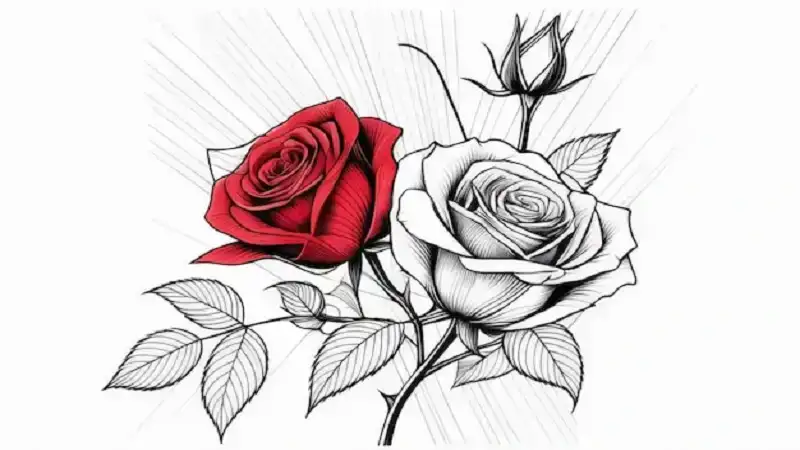Drawing is a skill that anyone can learn with practice and the right guidance. When it comes to “drawing:kkboxly=rose”, a symbol of beauty and elegance, many artists seek a simple yet effective method. The KKboxly technique offers an easy-to-follow approach that ensures beautiful results every time.
Materials You Need
Before starting, gather the following materials:
- Pencils (HB, 2B, and 4B)
- Eraser
- Drawing paper
- Sharpener
These basic tools will help you execute the KKboxly technique with precision.
Step-by-Step Guide
Step 1: Drawing the Basic Shapes
Begin by lightly sketching a small circle in the center of your paper. This will be the rose’s bud. Around this circle, draw a slightly larger circle to represent the outer petals.
Step 2: Outlining the Petals
Inside the small circle, draw a spiral starting from the center. This spiral will guide you in forming the inner layers of petals. Next, use the outer circle as a boundary to sketch the larger petals, giving the rose its characteristic layered look.
Step 3: Adding Details
With the basic shapes in place, start adding details to the petals. Draw wavy lines along the edges of the petals to create a more natural look. Pay attention to the way real rose petals fold and overlap.
Step 4: Shading for Depth
Shading is crucial in making your rose look realistic. Use the 2B pencil to add shadows where petals overlap and around the center of the rose. Gradually build up the darkness with the 4B pencil for deeper shadows. Use the HB pencil for lighter areas, blending the tones smoothly.
Step 5: Refining the Drawing
Erase any unnecessary lines from the initial sketch. Enhance the contours of the petals and add any final touches to the shading. Make sure the transitions between light and shadow are smooth to give the rose a three-dimensional appearance.
Tips for Success
Practice Regularly
Like any other skill, drawing improves with practice. Set aside time each day to practice the KKboxly technique and experiment with different types of roses.
Observe Real Roses
Study real roses to understand how the petals are arranged and how light interacts with them. This observation will improve your ability to replicate a rose’s intricate details in your drawings.
Use Reference Images
Having reference images can be incredibly helpful, especially when starting out. Use photographs or illustrations of roses to guide your drawing process.
Experiment with Different Styles
While the KKboxly technique provides a solid foundation, don’t be afraid to experiment with different styles. Try varying the line thickness, shading techniques, and even incorporating colors to make your rose drawings unique.
Common Mistakes and How to Avoid Them
Overcomplicating the Initial Sketch
Many beginners tend to overcomplicate the initial sketch. Remember, the first step is to create basic shapes that serve as a guide. Keep it simple with circles and spirals. You can add complexity as you progress.
Ignoring Light and Shadow
Shading is what gives your rose depth and realism. Avoid the mistake of using a single pencil for all shading. Utilize different grades of pencils to create varying levels of darkness and light. Pay attention to where the light source is coming from and shade accordingly.
Rushing the Process
“drawing:kkboxly= rose” requires patience. Take your time with each step, especially when adding details and shading. Rushing can lead to mistakes and a less polished final piece.
Advanced Techniques
Blending Tools
To achieve smoother shading, use blending tools such as blending stumps or tortillons. These tools help to soften the pencil marks and create a more natural gradient.
Adding Color
Once you’re comfortable with pencil sketches, try adding color to your roses. Colored pencils, watercolors, or pastels can bring your drawings to life. Start with light layers of color and gradually build up the intensity.
Incorporating Backgrounds
Adding a background can enhance your drawing and provide context. Simple backgrounds like leaves, stems, or a subtle gradient can make the rose stand out more. Be careful not to let the background overshadow the main subject.
Inspirational Ideas
Rose Bouquets
Instead of drawing a single rose, try creating a bouquet. This will challenge you to vary the sizes and angles of each rose, adding complexity to your artwork.
Different Varieties of Roses
Experiment with different types of “drawing:kkboxly= rose”, such as tea roses, wild roses, or hybrid roses. Each variety has unique characteristics that can help you expand your skills.
Thematic Drawings
Incorporate roses into thematic drawings. For instance, draw a rose intertwined with a clock to symbolize timeless beauty, or a rose growing through cracks in concrete to represent resilience.
Resources for Further Learning
Online Tutorials
Websites like YouTube and art-focused platforms offer numerous tutorials on “drawing:kkboxly= rose”. These can provide visual guidance and additional tips from experienced artists.
Art Books
Invest in art books that focus on botanical drawing or specifically on roses. These books often provide in-depth techniques and high-quality reference images.
Art Classes and Workshops
Consider taking a class or workshop. Learning in a structured environment with feedback from instructors can significantly improve your skills.
Conclusion
Mastering the “drawing:kkboxly= rose” using the KKboxly technique is within your reach. With patience, practice, and the right approach, you can create stunning, realistic rose drawings. Remember to enjoy the process, learn from each drawing, and continually seek inspiration and improvement. Happy drawing! See More


One thought on ““drawing:kkboxly= rose”: Mastering the Art with KKboxly”
Comments are closed.